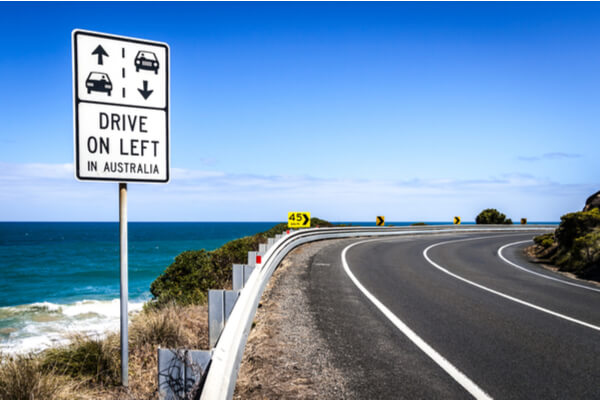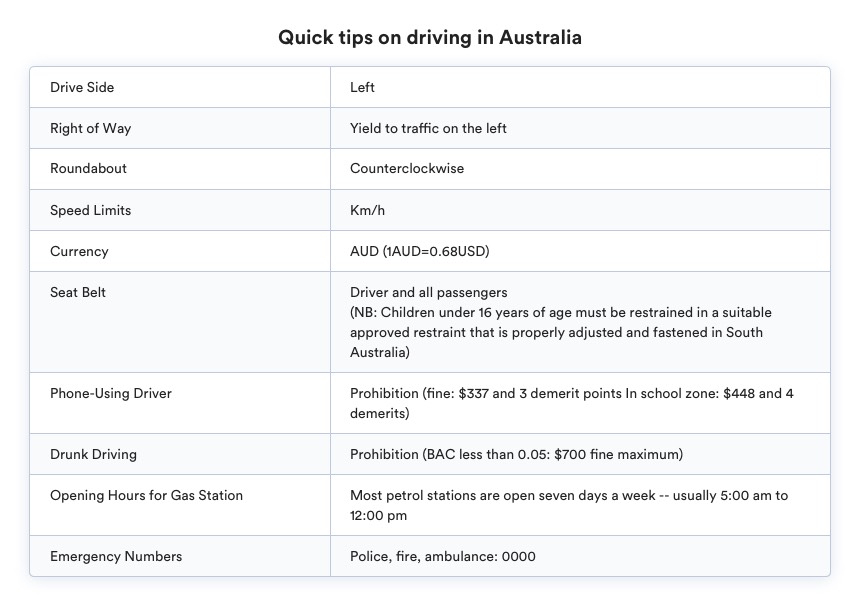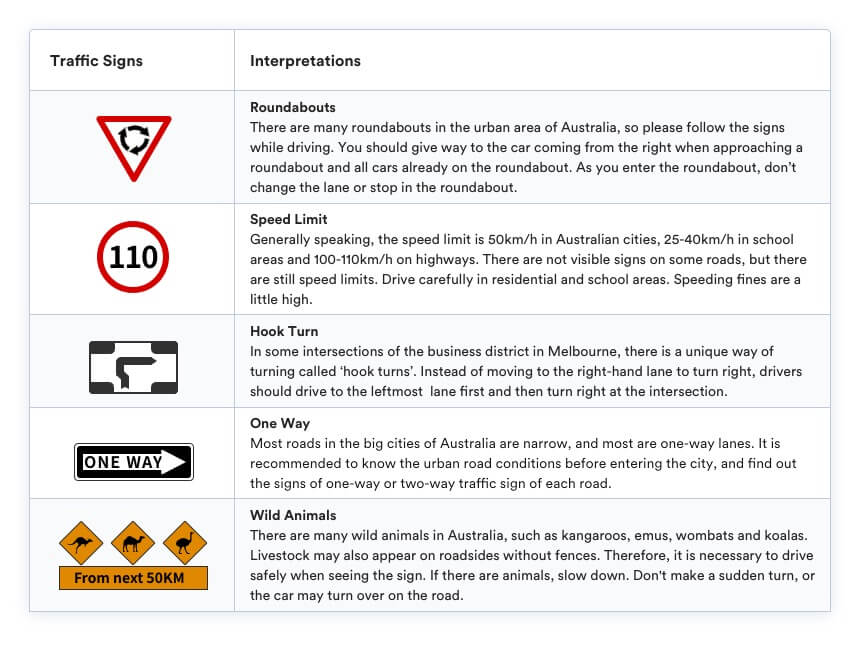With a vast territory and long coastline, Australia is famous for its road trips with pleasant scenery along the way, attracting thousands of road travelers every year. Driving in Australia is not difficult due to its extensive road system, well-constructed roads, reasonable traffic rules, and clear traffic signs. As long as you are familiar with and comply with traffic rules, you can easily drive. So get ready to start and enjoy an unforgettable road trip!
1. Driving Rules and Tips
- Speed Limits
Australian states and territories use two ‘default’ speed limits. These apply automatically in the absence of ‘posted’ speed restriction signage. The two default speed limits are:
i. Within built-up areas: 50 k/h (31 mph),
except for the Northern Territory which remains at 60 k/h (37 mph);
ii. Outside built-up areas: 100 k/h (62 mph),
two exceptions are Western Australia and the Northern Territory at 110 k/h (68 mph).
- Traffic and Road Signs
For more information about Australian road signs, here is an infographic from QEEQ.COM.
2. Road Condition and Toll Roads
Due to extensive road system and well-constructed roads, Australia is suitable for a road trip. However, there are various roads in rural and remote areas, such as asphalt roads, gravel roads, dirt roads, etc. So please drive carefully.
While traveling in Australia you may come across a unique sight – the road train. These road trains can be as long as 50 meters, so be careful when driving past them.
- Toll Roads
Most freeways in Australia are free, and only a small part of them are tolled. The toll highway will be marked ‘TOLL’ at the entrance of the road. The toll charges do not vary by mileage, but by toll roads and times traveled. That is to say, the toll is charged once regardless of the distance. There is a fixed price for each toll road. The fee for cars and commercial cars is A$1-5 per toll road, which is not so high.
It is suggested that when planning your journey, you can check in advance whether you will drive on the toll road. If so, GPS can be programmed to avoid toll roads. If you don’t plan on time and cannot avoid it, please pay in different ways.
How to pay?
There are not toll stations on toll roads and cars are monitored by the live traffic camera. Cars equipped with an electronic payment system can automatically be sensed and charged directly when passing toll stations.
It is suggested to rent the E-Tag (electronic toll tag) from the staff to pay tolls automatically when renting a car so that tolls can be directly charged from the authorized credit card as you pass toll points. But the administration fee will be charged.
3. Gas
There are different types of fuels in Australia, Diesel, Petrol, Gas, and Gasoline. The most common petrol types are Premium Unleaded 98, Premium Unleaded 95, Unleaded 91, Unleaded E10.
When refueling in Australia, you can follow the instructions on the car or the fuel tank cap and fill the tank with the designated fuel. If you are not sure which fuel to choose, consult the branch staff when picking up the car.
Be careful not to fill the tank with the wrong fuel. If you refuel with the wrong fuel, please contact the branch as soon as possible to clean up the fuel tank and the fuel system and conduct an overall inspection of the engine. Don’t start the car in haste to avoid car damage.
How to pay?
Australian gas stations are mostly self-service. You can pay by credit card and cash.
i. Refueling with credit card
ii. Refueling with cash
The steps are as follows:
Step1: Remember the nozzle number
Step2: Pay in cash at the counter
Step3: Choose the petrol type at the pump
Step4: Pick up the fuel pump nozzle and start filling up
Step5: Get your change back at the counter
Expert tips:
1. Most of the gas stations in Australia are in cities and towns. If you go to remote areas, please fill-up the tank in advance.
2. Petrol price varies with the region. Generally speaking, the price in large and medium-sized cities is lower than that in other regions. You can pay more attention to your road trip.
3. Some gas stations will not offer the refueling receipt voluntarily. If you refuel for the last time, you need to ask for the receipt and give it to the store clerk when returning the car, indicating that you return the car with a full tank.
4. There are coupons for refueling under the cash register tapes of Coles and Woolworth, two major supermarkets in Australia, which can be used if necessary.
4. Parking
- Public Parking
There are free public parking lots around the shopping center and supermarkets. Generally, in the scenic spots and prosperous areas, paid parking lots are available. Parking is free in Blue Mountains National Park, the Great Ocean Road in Victoria, etc.
- On-Street, Free Parking
Some free parking spaces on the roadside in Australia generally have time limits and there are signs for details. Posted signs will indicate the time limited for parking (hours, minutes), validity period or date for time-limited parking and parking guide arrow.
- On-Street, Metered Parking
In Australia, metered parking signs are similar to those for free parking but there is the word ‘Meter’ on them, indicating that parking in the area is subject to a time limit and a fee. The sign information is similar to that on the free parking sign. Meter means that there is a coined parking meter nearby. You can pay by credit card or cash. Parking Spaces are equipped with sensors that automatically alert staff nearby if you park overtime or without paying.
How to pay?
i. Paying at the parking meter
If you pay at the parking meter, generally you will be charged for 2 Australian dollars per hour. You can pay by Master/Visa credit card or coin.
Steps are as follows:
Step1: Insert coins/pay by card
Step2: Select the time
Step3: Confirm ok
Step4: Print the receipt
Step5: Place the receipt on the windshield
ii. Paying in the parking lot
If you pay in the parking lot, the fee is generally higher, sometimes up to about 10 Australian dollars per hour. Most are self-service, and you can pay by cash or credit card.
Expert tips: Please note that parking tickets should be carried with you and not left in the car.
5. Tickets
How to pay?
i. Most car rental companies can help customers to pay for the ticket. After receiving the violation information, they will charge the fine and administration fee from the credit card of the customers.
ii. Sometimes customers have to pay the fine by following the steps below:
Step1: Administration Fee is charged by suppliers
Step2: Users consult suppliers or QEEQ.COM for the charge
Step3: Users are informed of the administration fee and receive tickets from Traffic Administration
Step4: After receiving the ticket, users pay the fine based on the ticket number and the website
If there isn’t any violation record, the deposit will be returned to the debit card of the main driver within a month.
Expert tips: Please know whether there are toll road or toll bridge and any possible illegal behaviors in advance. It would be better to pay the fine as soon as possible in case of a high overdue fine.
Visit QEEQ.COM now.
QEEQ.COM guarantees the most competitive car rental deals for your travel and the secret is our Price Drop Protector program! We can automatically track your rental rates and RE-BOOK you if prices drop! See how our customers love this feature here.





